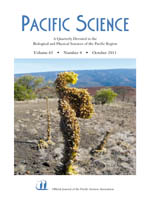A diet analysis was conducted on the gastrointestinal contents of 10 oceanic green turtles, Chelonia mydas, collected as bycatch mortalities in pelagic fisheries. Size distribution of the green turtles ranged from 30 to 70 cm curved carapace length (CCL). Prey items found indicated pelagic green turtles to be carnivorous with some omnivorous tendencies, foraging within the first 100 m of the water column. Most frequent identifiable prey items were Zooplankton, pelagic crustaceans, and mollusks (listed in order of frequency of occurrence, which ranged from 80% to 40% frequency): Pyrosoma spp., Lepas spp. (goose barnacles), amphipods, Carinaria spp. (sea snails), and Cavolinia spp. (sea butterflies). Other coelenterates such as salps, ctenophores, and cnidarians (jellyfish) were also identified. Plastics and anthropogenic debris were commonly found (70% frequency, mean = 4% of gastrointestinal content by volume). The turtles examined consisted of two distinct morphotypes corresponding to the central Pacific and the eastern Pacific green turtle populations. Genetic analysis confirmed turtles of the central Pacific morphotype to be of Hawaiian origin and at least one of the eastern Pacific morphotype turtles to have a mtDNA haplotype found in the population nesting in the Revillagigedo archipelago off Mexico. Other eastern Pacific morphotypical turtles had a different common Mexican haplotype found among the nesting populations throughout Mexico and the Galápagos. Turtles of the central Pacific morphotype were distributed north of the Hawaiian Islands, and turtles of the eastern Pacific morphotype were all encountered south of Hawai'i, suggesting a dichotomy in the oceanic distribution of these two populations. Our records of green turtles as large as 70 cm CCL in pelagic waters suggest that some green turtles, mainly those with eastern Pacific green turtle morphology and mtDNA haplotype, delay their recruitment to nearshore (neritic) habitats or move back and forth between neritic and open ocean waters as adults.
How to translate text using browser tools
1 October 2011
Oceanic Diet and Distribution of Haplotypes for the Green Turtle, Chelonia mydas, in the Central North Pacific
Denise M. Parker,
Peter H. Dutton,
George H. Balazs
ACCESS THE FULL ARTICLE

Pacific Science
Vol. 65 • No. 4
October 2011
Vol. 65 • No. 4
October 2011




